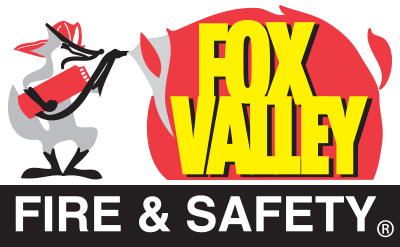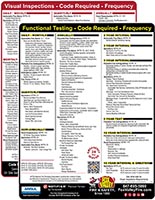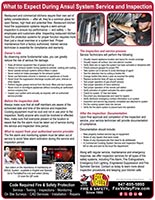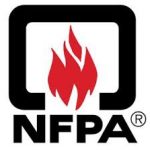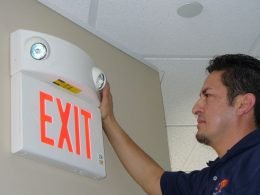Code Required Frequency of Functional Testing and Visual Inspections
The inspection, testing, and maintenance requirements for your building’s fire and safety systems are critical to ensuring the safety and code compliance of your facility. These requirements begin from the date of initial installation and are code required to continue at specific intervals throughout the lifespan of the devices and systems.
To assist you in navigating these code requirements, we have organized this guide into two key sections: Functional Testing and Visual Inspections. Each section outlines the NFPA Code Required Frequency along with the specific systems and devices that require testing and inspection at that interval.
Functional Testing Frequency | Visual Inspections Frequency
Functional Testing Frequency
Quick Reference Guide of common fire and safety systems and devices that are code required to be Functionally Tested at a specific frequency. Involves activating components of the fire and safety system to confirm they operate as intended and may require specialized equipment and trained technicians to perform the testing.
Skip to section: Visual Inspections Frequency
NFPA (National Fire Protection Association) specifies the minimum Codes and Standards requirements. Frequency may vary based on a risk analysis by your Insurance Company or AHJ (Authority Having Jurisdiction). Your facility may have additional or special equipment not covered in this guide. Codes Referenced: NFPA 72: 2013 edition, NFPA 25: 2014 edition, NFPA 10: 2013 edition, NFPA 17: 2013 edition, NFPA 17A: 2013 edition, NFPA 101: 2015 edition, ULCS536: 2004 edition. NFPA.org List of Codes and Standards
Skip to Interval / Frequency of Functional Testing:
- DAILY – MONTHLY TEST
- QUARTERLY TEST
- SEMI-ANNUALLY TEST
- ANNUALLY TEST
- 2 YEAR INTERVAL TEST
- 3 YEAR INTERVAL TEST
- 5 YEAR INTERVAL TEST
- 6 YEAR TEST
- 12 YEAR INTERVAL TEST
- 10 YEAR INTERVAL & GREATER TEST
DAILY – MONTHLY TEST
Automatic Fire Alarm ULC S536
Daily and Monthly Status Check
Supervisory field devices, Supervisory circuits and DCL, in-and-out conductors of supervised circuits, ancillary device control circuit, one initiating field device, operation of common audible and visual trouble signals, one emergency phone, voice paging capability to one zone. Battery terminals are clean and lubricated, terminal clamps are secure, electrolyte level and specific gravity.
Portable Fire Extinguishers NFPA 10
Monthly – Ensure in proper operating condition. Safety seals, tags, pressure gauge readings, HMIS Label
Emergency Lights NFPA 101
Monthly – 30 second quick check and battery check
Fire Pump NFPA 25
Weekly system procedures. Monthly – Electric 10 min. Weekly – Diesel 30 min.
QUARTERLY TEST
Sprinklers NFPA 25
Mechanical Water Flow Devices
Tank High and Low Alarms that do not Report to a Fire Panel that is Monitored 24 Hours a Day
Valves, Valve Components
Hose Valves/PRV’s
Main Drain (with Backflow Device)
Low Air Pressure Alarms
Quick Opening Devices
Priming Water
Master PRV Main Drain
SEMI-ANNUALLY TEST
Hood Suppression NFPA 17A
All Kitchen Suppression Systems
Sprinklers NFPA 25
Valve Supervisory Devices
High/Low Tank Alarms
Automatic Fire Alarm NFPA 72
Batteries – Fire Alarm Systems
Sealed Lead-Acid – Load Voltage Test
ANNUALLY TEST
Portable Fire Extinguishers NFPA 10
Conductivity test of all carbon dioxide hose assemblies. Ensure in proper operating condition. Safety seals, tags, pressure gauge reading, HMIS label. Empty and recharge all stored pressure loaded stream fire extinguishers.
Automatic Fire Alarm NFPA 72, ULC S536
Control Equipment: Building Systems Connected to Supervising Station
Functions, Fuses, Interface Equipment, Lamps & LEDs, Primary (main) Power Supply, Transponders
Batteries – Fire Alarm Systems
Control Unit Trouble Signs
Emergency Voice/Alarm Communications Equipment
Remote Annunciators
Initiating Devices
Duct Smoke Detectors
Electromechanical Releasing Devices
Fire Extinguishing System(s) or Suppression System(s) Switches
Fire Alarm Boxes (Pull Stations)
Fire Phones
Heat Detectors
All Smoke Detectors – Functional
Fire – Gas and other detectors
Interface Equipment
Special Hazard Equipment
Alarm Notification Devices
Audible Devices
Audible Textual Notification Appliances
Visible Devices
Supervising Station Fire Alarm System – Transmitters
Digital Alarm Communicator Transmitter (DACT), Digital Alarm Radio Transmitter (DART)
Special Procedures
Sprinklers NFPA 25
Main Drain
Antifreeze Solution
Valves, Valve Components
Pressure Reducing Valves/Relief Valves (part flow)
Master Pressure Reducing Valves (full flow)
Control Valves
Dry System, Partial Trip Test
Deluge, Pre-action Full Trip Test
Air Maintenance Device
Backflow Prevention Assemblies
Full Forward Flow Test
Private Fire Hydrant
Standpipe
Main Drain Test
Hose Valves
Valves (all types)
Private Fire Service Mains
Monitor Nozzles
Hydrants
Fire Pump System
Full Flow
Alarm Signals
Annual Maintenance
2 YEAR INTERVAL TEST
Automatic Fire Alarm NFPA 72
Smoke Detector Sensitivity Testing
3 YEAR INTERVAL TEST
Sprinklers NFPA 25
Dry System Full Flow Trip Test
Dry System Air Leakage
Water Tanks without Corrosion Protection
5 YEAR INTERVAL TEST
Portable Fire Extinguishers NFPA 10
Hydrostatic testing of Carbon Dioxide, wet chemical and foam Fire Extinguishers
Hydrostatic testing of cartridges associated with portable fire extinguishers and wheeled units
Hydrostatic testing of carbon dioxide hoses equipped with a shut-off valve.
Sprinklers NFPA 25
Gauges (Test or Replace)
Sprinklers – Extra-high Temperature/Corrosive Atmosphere
Internal Pipe Obstruction Inspection
Fire Department Connections
Hydrostatic Test Siamese Connections, (City of Pittsburgh every 3 years)
Standpipe – Full Flow Test Remote Point
Hose Connection Pressure Reducing Valves (full flow)
Hydrostatic Test Manual/Dry Standpipes
Standpipe Hoses – 5 year test for new fire hoses and every 3 years thereafter
Valves, Valve Components
Pressure Reducing Valves/Relief Valves (full flow)
Private Fire Service Mains
Full Flow Test
Internal Tank Test
Internal Backflow & Re-test
6 YEAR TEST
Portable Fire Extinguishers NFPA 10
Stored-pressure extinguishers requiring 6 year hydrostatic test shall be emptied and subjected to applicable maintenance procedures.
12 YEAR INTERVAL TEST
Portable Fire Extinguishers NFPA 10
Hydro test of dry chemical and clean agent extinguishers
Hydro test of dry chemical hose equipped with a shut-off valve
Hood Suppression NFPA 17A
Hydrostatic Testing
Cylinder
Replacement of cartridge
Regulator Test
Wet Chemical Containers
Auxiliary Pressure Containers
Hose Assemblies
10 YEAR INTERVAL & GREATER TEST
Sprinklers NFPA 25
Dry Type: At 10 years and every 10 years thereafter
Quick Response: At 20 years and every 10 years thereafter
Standard: At 50 years and every 10 years thereafter
Visual Inspections Frequency
Quick Reference Guide of common fire and safety systems and devices that are code required to be Visually Inspected at a specific frequency. It’s a visual assessment verifying that fire and safety components appear to be in operating condition, in proper location, and are free of physical damage or conditions that impair operation.
Skip to section: Functional Testing Frequency
NFPA (National Fire Protection Association) specifies the minimum Codes and Standards requirements. Frequency may vary based on a risk analysis by your Insurance Company or AHJ (Authority Having Jurisdiction). Your facility may have additional or special equipment not covered in this guide. Codes Referenced: NFPA 72: 2013 edition, NFPA 25: 2014 edition, NFPA 10: 2013 edition, NFPA 96: 2014 edition, NFPA 17: 2013 edition, NFPA 17A: 2013 edition, NFPA 101: 2015 edition, NFPA 70: 2017 edition, NFPA 2001, ULCS536: 2004 edition. NFPA.org List of Codes and Standards
Skip to Interval / Frequency of Visual Inspections:
- DAILY / WEEKLY INSPECT
- MONTHLY INSPECT
- QUARTERLY INSPECT
- SEMI-ANNUALLY INSPECT
- ANNUALLY INSPECT
- 5 YEARS INSPECT
- 10 YEARS / 12 YEARS INSPECT
DAILY / WEEKLY INSPECT
Automatic Fire Alarm NFPA 72
Control Panel Normal
Sprinklers NFPA 25
Gauges (Dry, Pre-action, and Deluge Systems)
Cold Weather Enclosures
Valves, Valve Components, Trim Inspections
Sealed Control Valves
Master Pressure Reducing
Fire Pump System
Casing Relief Valves
Pressure Relief Valves
Pump House, Heating Ventilating Louvers
Backflow Prevention Assemblies
Reduced Pressure Detectors
Control Valves (locked/supervised)
Standpipe
Sealed Control Valves
Gauges (Automatic Dry Standpipes)
MONTHLY INSPECT
Portable Fire Extinguishers NFPA 10
Location in designated place
No obstruction to access or visibility
Operating instructions on nameplate legible and facing outward
Safety seals and tamper indicators not broken or missing
Fullness determined by weighing or “hefting”
Examination for obvious physical damage, corrosion, leakage or clogged nozzle
Pressure gauge reading or indicator in the operable range or position
Condition of tires, wheels, carriage, hose, and nozzle checked (for wheeled units)
Hazardous Materials Identification System (HMIS) Label in place
Automatic Fire Alarm NFPA 72, ULC S536
Unmonitored Control Equipment: Check for Alarm, Supervisory, and Trouble Signals
Sprinklers NFPA 25
Gauges (wet, dry, pre-action, and deluge systems)
Valves, Valve Components, Trim Inspections
Locked/Supervised Control Valves
Valve Supervisory Switches
Tamper Switches
Alarm Valves (exterior bells)
Dry Pipe, Deluge, Pre-action Valves
Pressure Reducing Valves
Backflow Prevention Assemblies
Double Check Valves
Control Valves (locked/supervised)
Standpipe
Control Valves (locked/supervised)
Gauges (Automatic Dry Standpipes with Air Pressure Supervision)
Private Fire Service Mains
Hose Houses
Emergency Lights/Exit Signs NFPA 101, 70
Functional Test
Hood Suppression NFPA 17
Owners Inspections: Extinguishing system in proper location, manual actuators unobstructed, tamper seals intact, system tag in place, no obvious physical damage, pressure gauge in operable range, nozzle blow-off caps intact, no modifications to protected equipment
QUARTERLY INSPECT
Automatic Fire Alarm NFPA 72
Initiating Devices
Optical Flame Detectors, Water Flow Switches
Sprinklers NFPA 25
Waterflow Alarm and Signaling Devices, including mechanical devices (i.e. water motor gongs)
Valve Supervisory signal devices
Supervisory signal devices (except valve supervisory switches)
Gauges (Wet Pipe Systems)
Fire Department Connections
Pressure Reducing and Relief Valves
Hose Connections
Hose Racks
Hydraulic Design Information Sign
Backflow Prevention Assemblies
Standpipe
Private Fire Service Maintenance
SEMI-ANNUALLY INSPECT
Hood Suppression NFPA 96, 17, 17A
Certified Technician’s Inspection
Suppression System
Fusible Link Replacement
Engineered Suppression NFPA 2001
Visually Inspect All Clean Agent Field Devices
Automatic Fire Alarm NFPA 72, ULC S536
Control Equipment: Fire Alarm Systems Monitored for Alarm, Supervisory, and Trouble Signals
Fuses
Interfaced Equipment
Lamps and LEDs
Primary (main) Power Supply
Control Equipment: Fire Alarm Systems Unmonitored for Alarm, Supervisory, and Trouble Signals
Nickel-Cadmium
Sealed Lead-Acid
Transient Suppressors
Control Unit Trouble Signals
Emergency Voice/Alarm Communications Equipment
Remote Annunciators
Batteries
Sealed Lead-Acid
Initiating Devices
Air Sampling Smoke Detectors
Duct Smoke Detectors
Electromechanical Releasing Devices
Fire Extinguishing System(s) or Suppression System(s) Switches
Fire Alarm Boxes (Pull Stations)
Heat Detectors
Smoke Detectors
Interface Equipment
Alarm Notification Appliances – Supervised
Supervising Station Fire Alarm Systems – Transmitters
Digital Alarm Communicator Transmitter (DACT)
Sprinklers NFPA 25
Private Fire Service Mains
Monitor Nozzles
ANNUALLY INSPECT
Hood Suppression NFPA 17, 17A
Fusible Links
Cartridge (Hydrostatic Test/Replacement) – PYROCHEM (FM200)
Portable Fire Extinguishers NFPA 10
All of monthly inspection, plus conductivity test (Carbon Dioxide), Determination of 6 year or Hydro test, inspection of shell and nameplate, Hanger/seismic bracing
Automatic Fire Alarm NFPA 72, ULC S536
Control Equipment: Fire Alarm Systems Monitored for Alarm, Supervisory, and Trouble Signals
Fuses
Interfaced Equipment
Lamps and LEDs
Primary (main) Power Supply
Control Equipment: Fire Alarm Systems Unmonitored for Alarm, Supervisory, and Trouble Signals
Radiant Energy Fire Detectors
Supervisory Signal Devices
Waterflow Devices
Sprinklers NFPA 25
Pipe and Fittings (from floor)
Hangers/Seismic Bracing (from floor)
Sprinklers (from floor)
Spare Sprinklers
Hydraulic Design Information Sign
Standpipe
Piping
Hose Racks
Hose Connections/Hose Valves
Hose/Hose Nozzles
Valves, Valve Components, Trim Inspection
Interior Dry, Deluge, Pre-action
Pressure Reducing Valves
Private Fire Service Mains
Hydrants
Main Line Strainers
Emergency Lights/Exit Signs NFPA 101, 70
90 Minute drain test and inspection, verification of charge voltage, alignment of heads, hazard assessment, inspection sticker, required paperwork
5 YEARS INSPECT
Sprinklers NFPA 25
Internal Pipe Inspection/Assessment
Valves, Valve components, Trim Inspections
Strainers, Filters, Orifices
Interior Check Valves
Interior Alarm
10 YEARS / 12 YEARS INSPECT
Hood Suppression NFPA 17, 17A
Regulator
Tank Cylinder (Hydrostatic Test)
Cartridge (Hydrostatic Test/Replacement) – ANSUL
Actuation Hose (Hydrostatic Test/Replacement)
